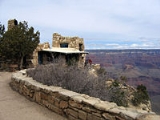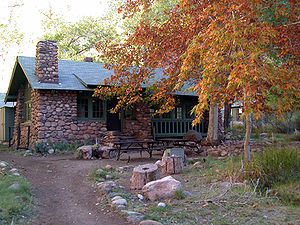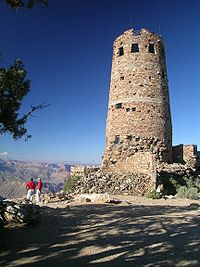
Mary Colter
Encyclopedia


Mary Elizabeth Jane Colter (April 4, 1869 Pittsburgh, Pennsylvania
Pittsburgh, Pennsylvania
Pittsburgh is the second-largest city in the US Commonwealth of Pennsylvania and the county seat of Allegheny County. Regionally, it anchors the largest urban area of Appalachia and the Ohio River Valley, and nationally, it is the 22nd-largest urban area in the United States...
– January 8, 1958) was an American architect and designer.
As a child, Mary Colter traveled with her family through frontier Minnesota, Colorado and Texas in the years after the American Civil War
American Civil War
The American Civil War was a civil war fought in the United States of America. In response to the election of Abraham Lincoln as President of the United States, 11 southern slave states declared their secession from the United States and formed the Confederate States of America ; the other 25...
. After her father died in 1886, Colter attended the California School of Design in San Francisco. In 1901, the Fred Harvey Company
Fred Harvey Company
The origin of the Fred Harvey Company can be traced to the 1875 opening of two railroad eating houses located at Wallace, Kansas and Hugo, Colorado on the Kansas Pacific Railway. These cafés were opened by Fred Harvey, then a freight agent for the Chicago, Burlington and Quincy Railroad...
(of the famous Harvey House
Harvey House
Harvey House may refer to:*One of many hotels of the Fred Harvey Company in the U.S. west, which include :*La Posada Hotel and Gardens, in Winslow, Arizona, a contributing property in NRHP-listed La Posada Historic District, in Navajo County...
s) offered her the job of decorating the Alvarado Hotel in Albuquerque. Colter began working full-time for the company in 1910, moving from interior designer to architect.
For the next thirty years, working as one of few female architects and in rugged conditions, Colter completed 21 projects for Fred Harvey. She created a series of landmark hotels and commercial lodges through the southwest, including the La Posada, the 1922 Phantom Ranch
Phantom Ranch
Phantom Ranch is a resort village within Grand Canyon National Park in Arizona. It is located on the north side of the Colorado River near its confluence with Bright Angel Creek and Phantom Creek.-History:...
buildings at the bottom of the Grand Canyon
Grand Canyon
The Grand Canyon is a steep-sided canyon carved by the Colorado River in the United States in the state of Arizona. It is largely contained within the Grand Canyon National Park, the 15th national park in the United States...
, and five structures on the south rim of the Grand Canyon: the Hopi House
Hopi House
Hopi House is located on the South Rim of the Grand Canyon, within Grand Canyon National Park in the U.S. state of Arizona. Built in 1905 as concessioner facilities at the South Rim were being developed, it is the first of of six buildings at the Grand Canyon that were designed by architect Mary...
(1905), Hermit's Rest
Hermit's Rest
Hermit's Rest is a structure built in 1914 at the western end of Hermit Road at the south rim of the Grand Canyon in Arizona, United States. The Hermit Trail, a hiking trail that extends to the Colorado River, begins about ¼ mile beyond the shuttle bus stop at Hermit's Rest. Hermit's Rest also...
(1914), the observatory Lookout Studio
Lookout Studio
Lookout Studio, known also as The Lookout, is a stone building located on the South Rim of the Grand Canyon, within Grand Canyon National Park in Arizona. It is part of the Grand Canyon Village Historic District, and is part of the Mary Jane Colter Buildings National Historic Landmark...
(1914), the 70-foot Desert View Watchtower
Desert View Watchtower
Desert View Watchtower, also known as the Indian Watchtower at Desert View, is a -high stone building located on the South Rim of the Grand Canyon within Grand Canyon National Park in Arizona, United States. The tower is located at Desert View, more than to the east of the main developed area at...
(1932) with its hidden steel structure, and the Bright Angel Lodge
Bright Angel Lodge
Bright Angel Lodge is a hotel complex at the South Rim of the Grand Canyon in Grand Canyon National Park, Arizona. Designed by architect Mary Jane Colter, the lodge is a complex of cabins around a central lodge building, directly on the edge of the canyon...
(1935); Colter decorated, but did not design, the El Tovar Hotel
El Tovar Hotel
The El Tovar Hotel, also known simply as El Tovar, is a former Harvey House hotel situated directly on the south rim of the Grand Canyon in Arizona, USA...
. The four "Mary Jane Colter Buildings
Mary Jane Colter Buildings
The Mary Jane Colter Buildings are four structures at Grand Canyon National Park designed by Mary Colter:* Hermit's Rest* Desert View Watchtower* Lookout Studio, also known as The Lookout* Hopi House...
", as a group, were listed as a National Historic Landmark
National Historic Landmark
A National Historic Landmark is a building, site, structure, object, or district, that is officially recognized by the United States government for its historical significance...
in 1987. She worked with Pueblo Revival Style architecture
Pueblo Revival Style architecture
The Pueblo Revival style is a regional architectural style of the Southwestern United States which draws its inspiration from the Pueblos and the Spanish missions in New Mexico. The style developed at the turn of the 20th century and reached its greatest popularity in the 1920s and 1930s, though it...
, Spanish Colonial Revival architecture, Mission Revival Style architecture
Mission Revival Style architecture
The Mission Revival Style was an architectural movement that began in the late 19th century for a colonial style's revivalism and reinterpretation, which drew inspiration from the late 18th and early 19th century Spanish missions in California....
, Streamline Moderne
Streamline Moderne
Streamline Moderne, sometimes referred to by either name alone or as Art Moderne, was a late type of the Art Deco design style which emerged during the 1930s...
, American Craftsman
American Craftsman
The American Craftsman Style, or the American Arts and Crafts Movement, is an American domestic architectural, interior design, landscape design, applied arts, and decorative arts style and lifestyle philosophy that began in the last years of the 19th century. As a comprehensive design and art...
, and Arts and Crafts Movement
Arts and Crafts movement
Arts and Crafts was an international design philosophy that originated in England and flourished between 1860 and 1910 , continuing its influence until the 1930s...
styles, often synthesizing several together evocatively.
Fred Harvey conquered the west along the Atchison, Topeka and Santa Fe Railway
Atchison, Topeka and Santa Fe Railway
The Atchison, Topeka and Santa Fe Railway , often abbreviated as Santa Fe, was one of the larger railroads in the United States. The company was first chartered in February 1859...
through strategic use of pretty girls in high-necked collars, tourism, and souvenirs. He had anthropologists on staff to locate the most likely Native American art forms and artifacts like pottery, jewelry, and leatherwork. He had merchandisers on staff to redesign those artifacts into goods. And he had Mary Colter on staff to produce vernacular commercial architecture in strategic locations, based on some concern for authenticity, floorplans calculated for good user experience and commercial function, and a playful sense of dramatic theme inside and out.

The Bright Angel became a de facto model for subsequent National Park Service
National Park Service
The National Park Service is the U.S. federal agency that manages all national parks, many national monuments, and other conservation and historical properties with various title designations...
and Civilian Conservation Corps
Civilian Conservation Corps
The Civilian Conservation Corps was a public work relief program that operated from 1933 to 1942 in the United States for unemployed, unmarried men from relief families, ages 18–25. A part of the New Deal of President Franklin D...
structures in the following years, influencing the look and feel of an entire architectural genre some call National Park Service rustic
National Park Service Rustic
National Park Service rustic, also colloquially known as Parkitecture, is a style of architecture that arose in the United States National Park System to create buildings that harmonized with their natural environment. Since its founding, the National Park Service consistently has sought to provide...
, and setting the precedent for using site materials and bold, large-scale design elements (the use of native fieldstone and rough-hewn wood at the bottom of the Grand Canyon was deemed the only practical thing to do). The Bright Angel Lodge also has a remarkable "geological fireplace" in the lodge's History Room, with rocks arranged floor to ceiling in the same order as the geologic strata in the canyon walls.
Colter's masterwork was probably the 1923 El Navajo in Gallup, New Mexico
Gallup, New Mexico
- Demographics :As of the census of 2000, there were 20,209 people, 6,810 households, and 4,869 families residing in the city. The population density was 1,513.7 people per square mile...
. Remarkable for its forward-looking blend of modern and Pueblo Revival Style architecture
Pueblo Revival Style architecture
The Pueblo Revival style is a regional architectural style of the Southwestern United States which draws its inspiration from the Pueblos and the Spanish missions in New Mexico. The style developed at the turn of the 20th century and reached its greatest popularity in the 1920s and 1930s, though it...
and the incorporation of Navajo
Navajo Nation
The Navajo Nation is a semi-autonomous Native American-governed territory covering , occupying all of northeastern Arizona, the southeastern portion of Utah, and northwestern New Mexico...
sand paintings, the hotel was razed shortly before Colter's death. Of all of her work, though, Colter considered the sprawling, hacienda-style Spanish Colonial Revival architecture La Posada Hotel (1929) in Winslow, Arizona, her masterpiece. She designed the entire resort from the building to its gardens, furniture, china—even the maids' uniforms. The Santa Fe railroad closed the hotel in 1957, and the hotel was later turned into a drab 1960s office building. Fortunately, the hotel and gardens have recently been restored to its original grandeur.
Late in her career, Colter designed the exuberant station cafe and a surprisingly sleek, Streamline Moderne
Streamline Moderne
Streamline Moderne, sometimes referred to by either name alone or as Art Moderne, was a late type of the Art Deco design style which emerged during the 1930s...
cocktail lounge at Union Station
Union Station (Los Angeles)
Los Angeles Union Station is the main railway station in Los Angeles, California. The station has rail services by Amtrak and Amtrak California and Metrolink; light rail/subways are the Metro Rail Red Line, Purple Line, Gold Line. Bus rapid transport runs on the Silver Line...
in Los Angeles, now padlocked except for occasional movie shoots and Los Angeles Conservancy
Los Angeles Conservancy
The Los Angeles Conservancy is an historic preservation organization in Los Angeles, California. It works to document, rescue and revitalize historic buildings, places and neighborhoods in the city. The Conservancy is the largest membership based historic preservation organization in the country...
tours. Mary Colter retired to Santa Fe, New Mexico
Santa Fe, New Mexico
Santa Fe is the capital of the U.S. state of New Mexico. It is the fourth-largest city in the state and is the seat of . Santa Fe had a population of 67,947 in the 2010 census...
in 1948 and donated her collection of Native American pottery
Native American pottery
Native American pottery is an art form with at least a 7500-year history in the Americas. Pottery is fired ceramics with clay as a component. Ceramics are used for utilitarian cooking vessels, serving and storage vessels, pipes, funerary urns, censers, musical instruments, ceremonial items, masks,...
and Indian relics to Mesa Verde National Park
Mesa Verde National Park
Mesa Verde National Park is a U.S. National Park and UNESCO World Heritage Site located in Montezuma County, Colorado, United States. It was created in 1906 to protect some of the best-preserved cliff dwellings in the world...
.
See also
- Mary Jane Colter buildings
- Fred Harvey

